Easy Homemade Tsukemen (Japanese Dipping Ramen Noodles)
on Oct 14, 2020, Updated Jan 25, 2021
This post may contain affiliate links. Please read my disclosure policy.
Easy homemade Tsukemen is delicious and comforting with Japanese ramen noodles, a flavorful dipping broth, tender pork belly, fresh veggies, and a soft cooked egg. It’s tastier and healthier than the restaurant version, but on the table in less than 30 minutes.
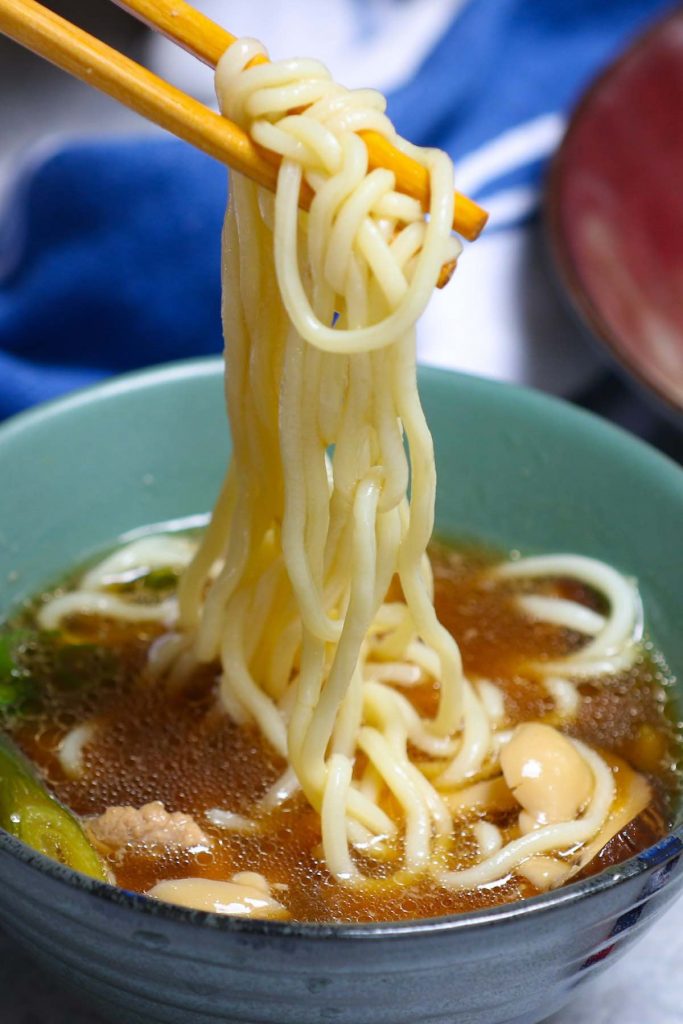
When I was living in Tokyo, Japan, I loved going to this local ramen-ya that makes the most flavorful tsukemen dipping noodles. It’s true that the real Japanese tsukemen takes years and great skill to perfect, but I wanted to create a simple dish with ingredients that I can easily find in North America.
My version is ready in less than 30 minutes. While it’s not completely authentic, it’s so comforting and flavorful – mouth-watering delicious!
What is Tsukemen?
Tsukemen is a delicious noodle dish in Japanese cuisine where cold ramen noodles are served with a separate bowl of hot broth or soup for dipping. It’s originally from Tokyo and means “dipping ramen” in Japanese (つけ麺). Recently, it has become popular in many American cities like Los Angeles.
Ingredients and Substitutes

- Ramen Noodles – I like fresh ramen noodles which you can find at local Japanese grocery stores or online, but you can also use dry ramen noodles.
- Pork Belly – Thinly sliced pork belly adds a unique layer of flavor to the broth. If you don’t have pork belly at home, you can sub bacon pieces.
- Garlic & Ginger – Use fresh garlic and ginger for the best flavor.
- Vegetable Oil – It has a high smoke point so don’t substitute with extra virgin olive oil.
- Chicken Stock – It adds so much flavor to the dipping soup. I recommend using reduced sodium to lower the salt intake.
- Soy Sauce – I used low-sodium soy sauce in this recipe. You can sub regular soy sauce.
- Green Onions – You’ll need to use the white part of the green onion for the broth, and the green part for garnish.
- Mushrooms – I used shiitake mushrooms and shimeji mushrooms. You can sub with your favorite mushrooms.
- Mirin – It’s an essential condiment in Japanese cuisine. Mirin adds a sweet and tangy flavor to the broth. Substitute dry sherry if you prefer.
- Rice Vinegar – It adds a nice acidity to the broth and provides a lip-smacking zing. It also balances out the rich and sweet flavours. You can sub white vinegar.
- Salt and Pepper – You can add salt and pepper in the end to your personal taste.
- Sesame Oil – It adds an authentic nutty flavor to the dish.
- Eggs – Traditional Tsukemen is served with soft-boiled eggs. You can find how to make them in the recipe card.
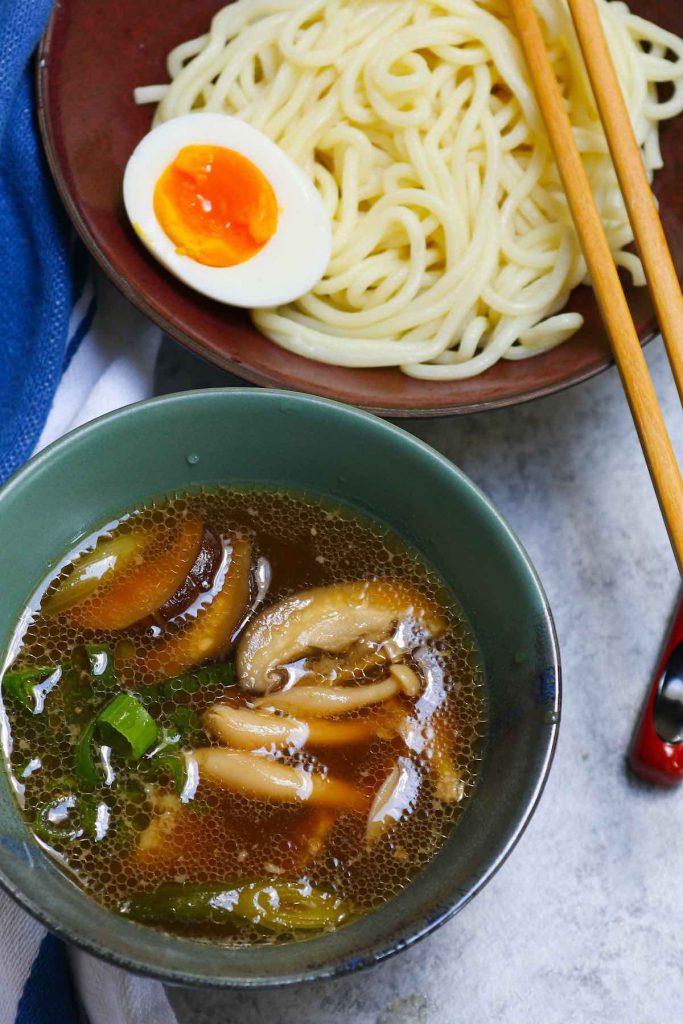
How to Make Tsukemen Ramen at Home
Tsukemen is comprised of 3 elements: the dipping ramen noodles, the broth, and the toppings. Each element is crucial to making Tsukemen.
Dipping Noodles
Cook the ramen noodles according to the instruction, and soak in cold water. This prevents the noodles from becoming gummy and clump together. It also helps to tighten the noodles, making it springy and chewy.
Tsukemen Broth
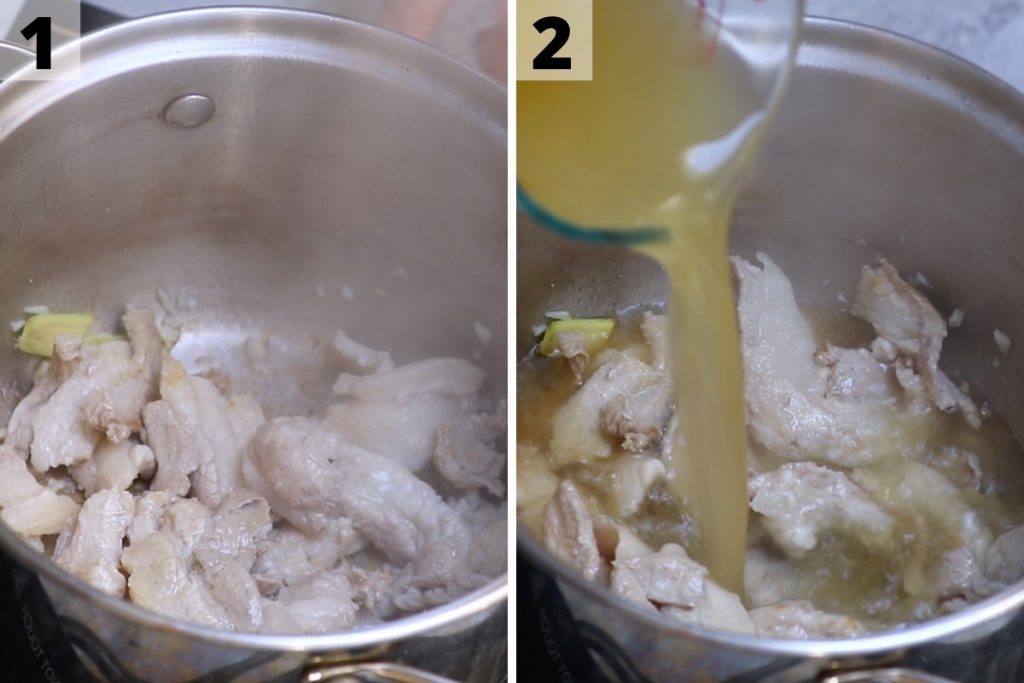
1. Heat oil in a large pot over medium heat, add garlic and ginger, and cook until fragrant. Then add pork belly, and stir-fry until no longer pink.
2. Add chicken stock, soy sauce and mirin. Cover and bring to a boil.
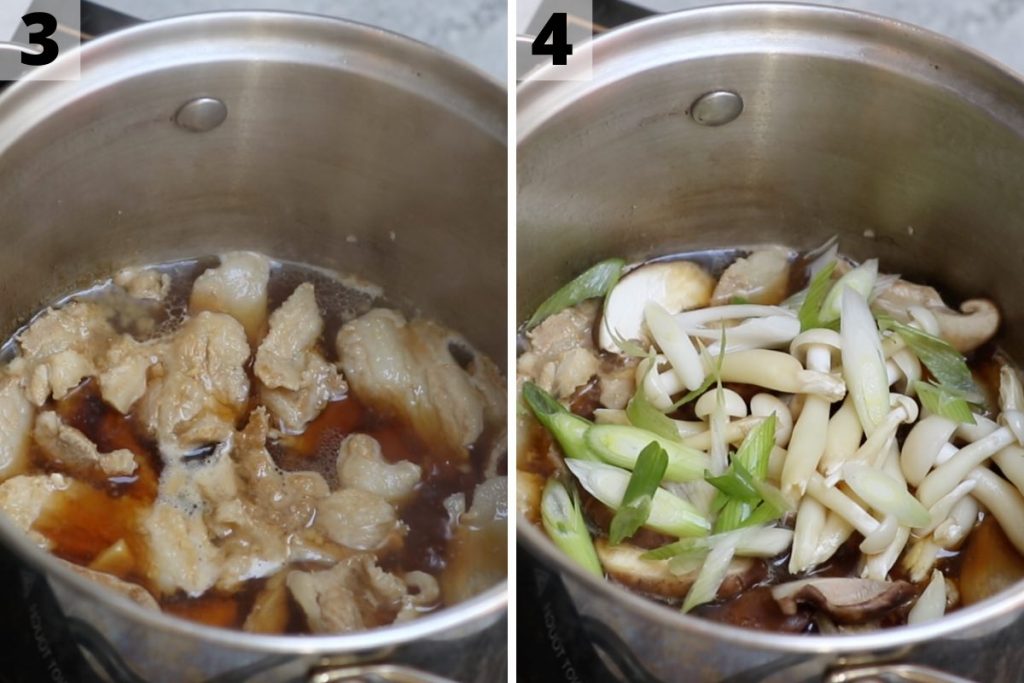
3. Remove the lid, lower the heat and simmer for 10 minutes.
4. Add mushrooms and green onions. Bring it to a boil on high heat.
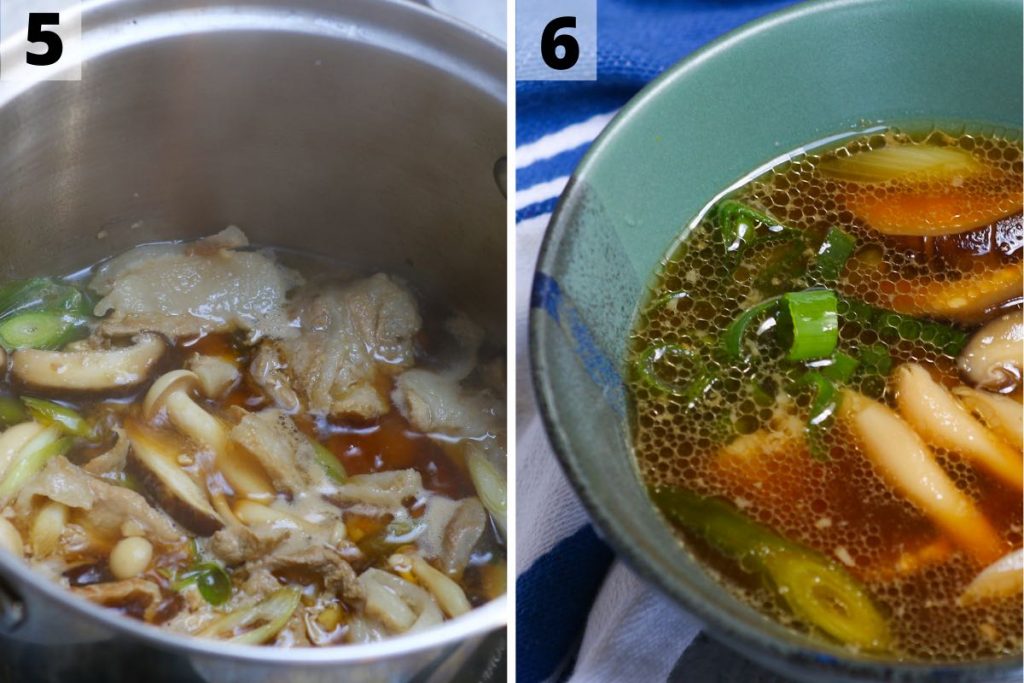
5. Adjust the heat to low and simmer for another 5 minutes until the mushroom has softened.
6. Add sesame oil and rice vinegar. Season with salt and pepper, to taste. Stir lightly. Turn off the heat and set aside.
The Toppings
I served my tsukemen ramen with soft-boiled eggs and green onions. You can top it with other ingredients like nori, menma, and fish cake.
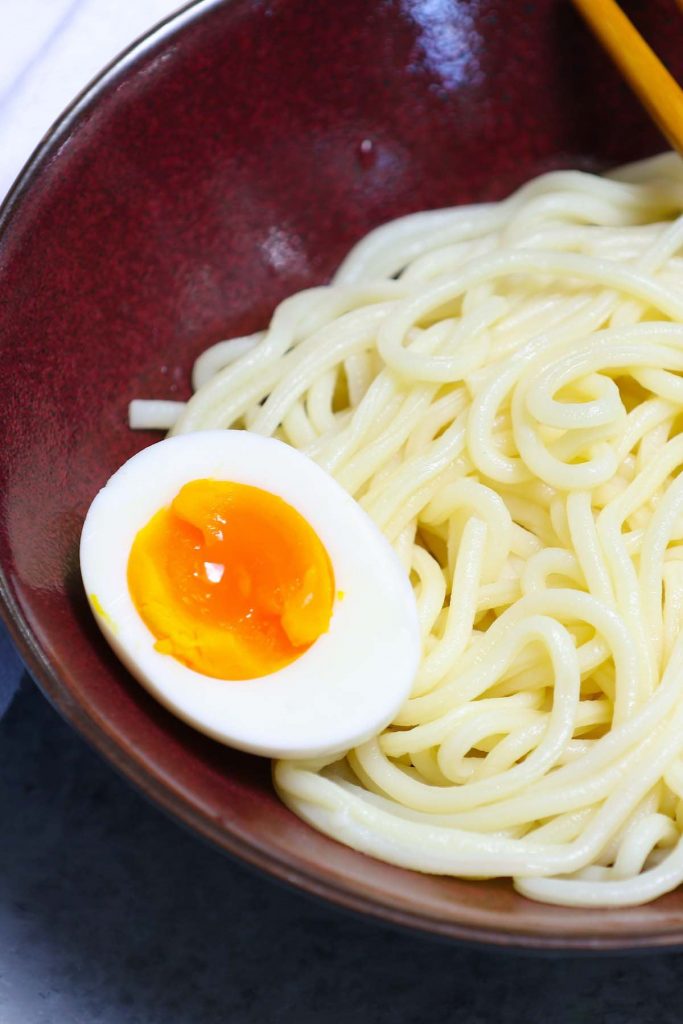
Tips & Tricks
- Make sure to soak your ramen noodles in cold water after cooking so that it can stay springy and chewy.
- If your pork belly is not pre-sliced, you can place it in the freezer for 30 to 45 minutes to firm it up before cutting. The meat will become much easier to slice when it’s half frozen. Cut it into thin slices for this recipe.
- You can add hot chili oil to the broth if you’d like to add some heat to your dish.
- When making soft-boiled eggs, it’s best to soak the cooked eggs in an ice bath for easy peeling.
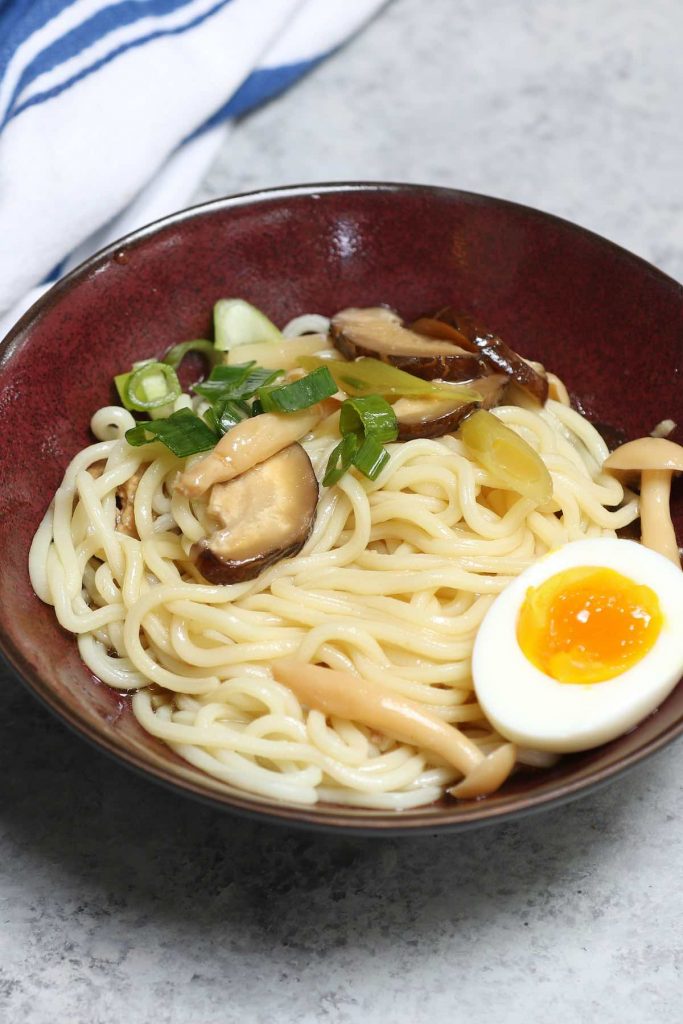
Frequently Asked Questions
How to Eat Tsukemen?
Tsukemen is often served in summer. Pick up just enough cold ramen noodles to eat in one bite, dip them completely into the hot broth so that they can warm up slightly, and then enjoy!
Do You Drink Tsukemen Broth / Dipping Sauce?
Tsukemen broth tends to be saltier with more intense flavors then ramen broth, as a result, it’s meant for dipping only.
What’s the Difference Between Tsukemen and Ramen?
Tsukemen is a noodle dish where cold ramen noodles and the hot soup are served separately, while Ramen consists hot noodles served in a meat-based broth.
If You Like This Recipe Try These Out:


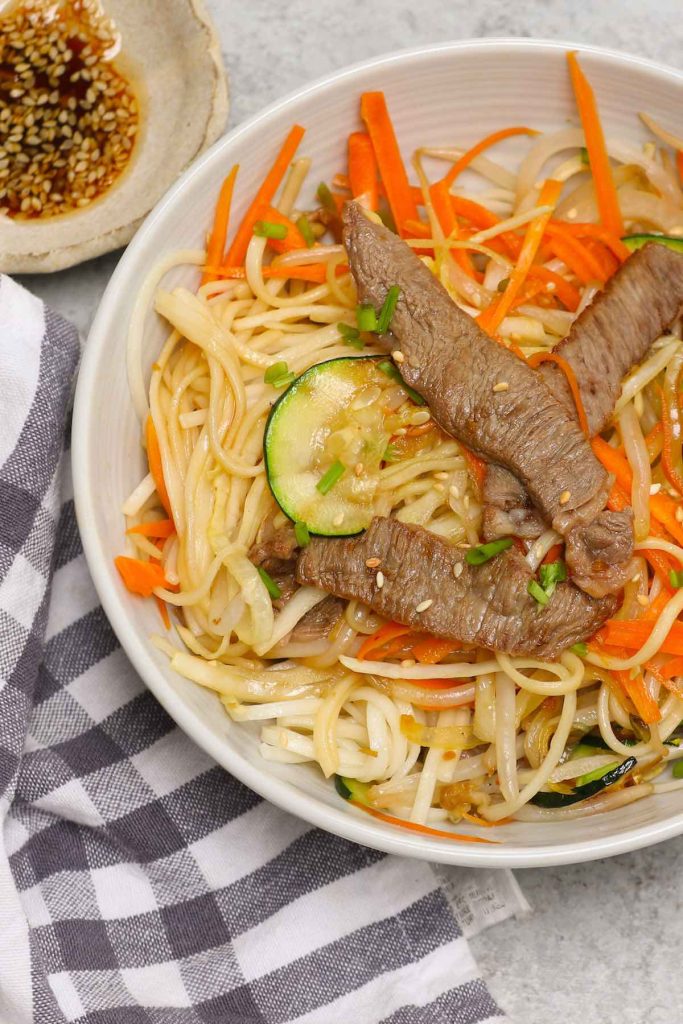

I hope you like this recipe, and if you tried it, let me know how your Tsukemen turns out in the comments below!
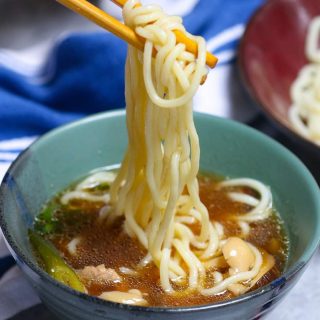
Tsukemen Ramen Recipe (+Video)
Ingredients
Ramen Noodles
- 2 packages ramen noodles, (This is for 2 servings. You’ll need about 4-oz fresh noodles, or 2-oz dry noodles for each serving)
Tsukemen Broth
- 1/2 tablespoon vegetable oil
- 1/2 lb pork belly, (thinly sliced, you can also use bacon if you cannot find pork belly)
- 2 cloves garlic, minced
- 2 teaspoon freshly grated ginger
- 2 cups chicken stock, (I used reduced sodium)
- 3 tablespoons low-sodium soy sauce
- 2 green onions / scallions
- 2 shiitake mushrooms, (You can sub other mushrooms)
- 1/2 cup shimeji mushrooms, (You can sub your favorite mushrooms)
- 2 tablespoons mirin, (Use dry sherry or cooking wine if you prefer)
- 1/2 teaspoon rice vinegar, (You can sub white vinegar or apple cider vinegar)
- salt and pepper, to taste
- 1 teaspoon sesame oil
Toppings
- 2 soft-boiled eggs
- chopped green onions
Instructions
Make the tsukemen broth
- Prepare the ingredients: cut the pork belly into thin slices and then cut into 2-inch pieces; mince the garlic and ginger; chop green onions, and slice mushrooms.
- Heat oil in a large pot over medium heat. Add garlic and ginger, and cook until fragrant, about 1-2 minutes, stirring frequently.
- Add pork belly, and stir-fry until no longer pink.
- Add chicken stock, soy sauce and mirin.
- Cover and bring to a boil. Remove the lid, lower the heat and simmer for 10 minutes. While you are waiting, you can make soft-boiled eggs (see below).
- Add green onions and mushrooms. Bring it to a boil on high heat.
- Adjust the heat to low and simmer for another 5 minutes until the mushroom has softened.
- Add sesame oil and vinegar. Season with salt and pepper to taste. Stir lightly. Remove from heat and set aside.
Make the soft-boiled eggs
- Fill a saucepan with water (make sure there’s enough water to cover the eggs), and bring to a boil. Gently lower cold-from-the-fridge eggs into the water. Simmer for 7 ½ minutes, adjusting the heat as necessary to maintain a gentle boil.
- Transfer the cooked eggs to iced water and chill for 3 minutes. Crack the eggs all over, peel the shell and slice in half lengthwise.
Cook Ramen Noodles
- Boil water in a large pot and add ramen noodles. Cook according to the instructions on the package. Once cooked, rinse the noodles under running water, and soak them in a bowl of cold water to cool. Drain completely and divide the noodles into 2 bowls.
- Serve tsukemen: Place noodles into individual bowls, and place soft-boiled eggs on top of the noodles. Add tsukemen broth and vegetables in a separate bowl, then top with chopped green onions.
Video
Notes
- Make sure to soak your ramen noodles in cold water after cooking so that it can stay springy and chewy.
- If your pork belly is not pre-sliced, I recommend placing it in the freezer for 30 to 45 minutes to firm it up so that you can easily cut it into thin slices.
- You can add hot chili oil to the broth if you’d like to make your soup spicy.
Nutrition
Nutrition information provided is an estimate only and will vary based on ingredient brands and cooking methods used.



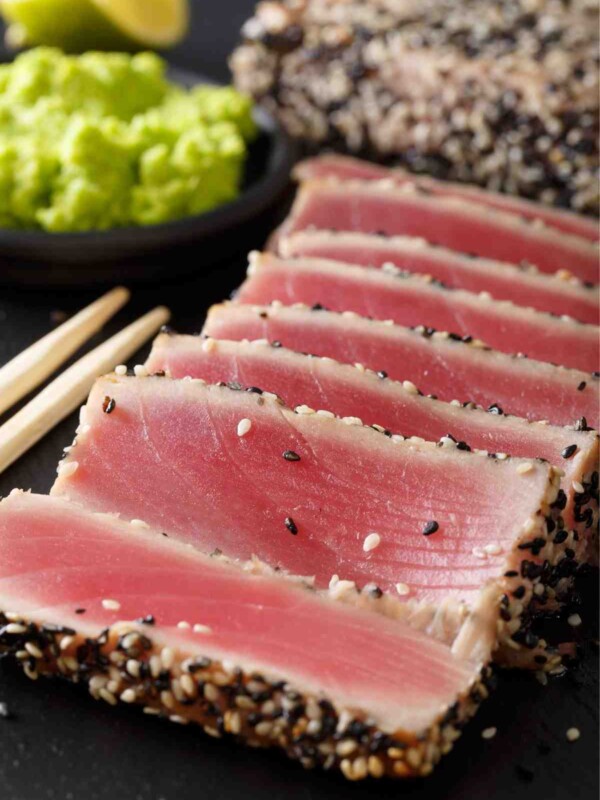

I’ve been exploring Asian recipes lately, and a simple well-cooked ramen-based recipe such as this one is something that I’m looking forward to trying! Tysm!
You had me at “dipping noodles” !!! THESE WERE so so delicious! Now on regular rotations.
Love your recipe been making it for a while now. Tsukemen is my favorite and your recipe is on point with any of the ramen spots around me. I make a bigger batch and freeze the broth portions in individual servings. On days I want it just make my egg and noodles, grab the broth and heat up and good to go!
Hi Julia, glad you like this recipe. Thanks for letting me know